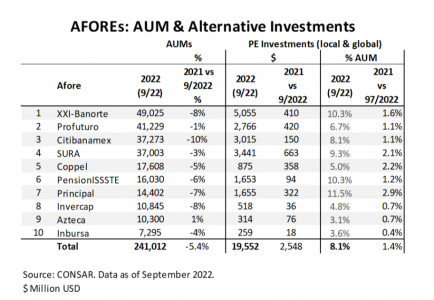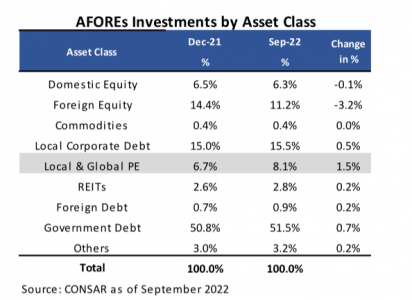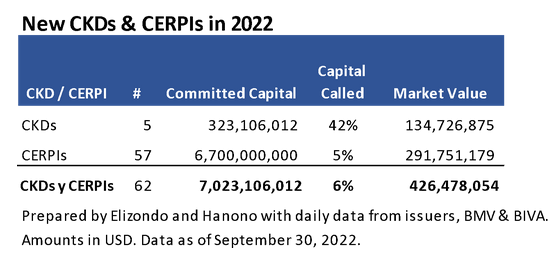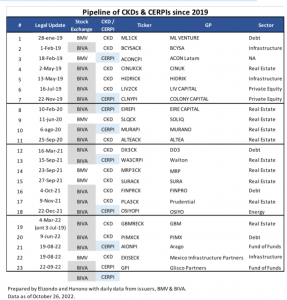Assets under management of the AFOREs in 2022 have had a drop of $13.9B to September, closing the month at $241.0B. Back in December 2021 they were at $254.9B according to CONSAR information. This represents a 5.4% drop. Some AFOREs experienced a 10% reduction of their assets, while in the extreme case there is one that managed to achieve a slight increase of at least 1%. In the previous year, assets grew 7% on average.
All AFOREs increased their percentage of investment in alternatives in percentages ranging from 0.4% to 2.9%, with an average growth of 1.4%.
Between December 2021 and September 2022 there is an increase of $2.5B in alternative investments, bringing these investments to $19.6B which means an increase from 6.7% to 8.1% as a percentage of investment between December 2021 and September 2022. According to our own estimates, 2.6% are international investments and 5.5% are local at market value.

The decline in local and international equity investments accumulated during the year largely explains this drop in assets under management. Between December 2021 and September 2022, local equities dropped 0.2% of their weight in the portfolio from 6.5% to 6.3% and investments in international equities dropped from 14.4% to 11.2%, which is a drop in the portfolio of 3.2%.
This increase in the percentage invested in alternatives and decrease in the percentages of local and international equities is called the denominator effect. The denominator effect refers to the value of an investor’s private equity portfolio exceeding his or her allocation due to a decrease in the value of other elements of the investment portfolio.

In 2022 the issuance of vehicles seeking global investments in the fund of funds sector continues to dominate. Between January and September 5 CKDs and 57 CERPIs emerged signifying new commitments for $7B of which only 6% have been called which have a market value of $426M according to proprietary information.

With these new issues in only four years the CERPIs are about to reach the number of CKDs (128 CKDs vs. 136 CERPIs) and the same happens with the committed resources ($23.6B in CKDs vs. $21.1B in CERPIs) with the difference that 77% of the commitments have been called in CKDs and only 27% in CERPIs. It should be considered that the first CKD was issued 13 years ago.

In the new 2022 pipeline there are only 3 CKDs and 2 CERPIs where the amounts are expected to continue to dominate in CERPIs. BIVA brings 4 of the issues and BMV 1. As for the sectors two are located in funds of funds and one in infrastructure, real estate and debt respectively.

In the composition of the AFOREs’ portfolios, the drop in assets and the increase in the weight of alternative investments will cause investments in this asset class to take a break in general terms, where the doubt is the time for recovery in equities with a recession at the door to cause the opposite effect.
Column by Arturo Hanono

